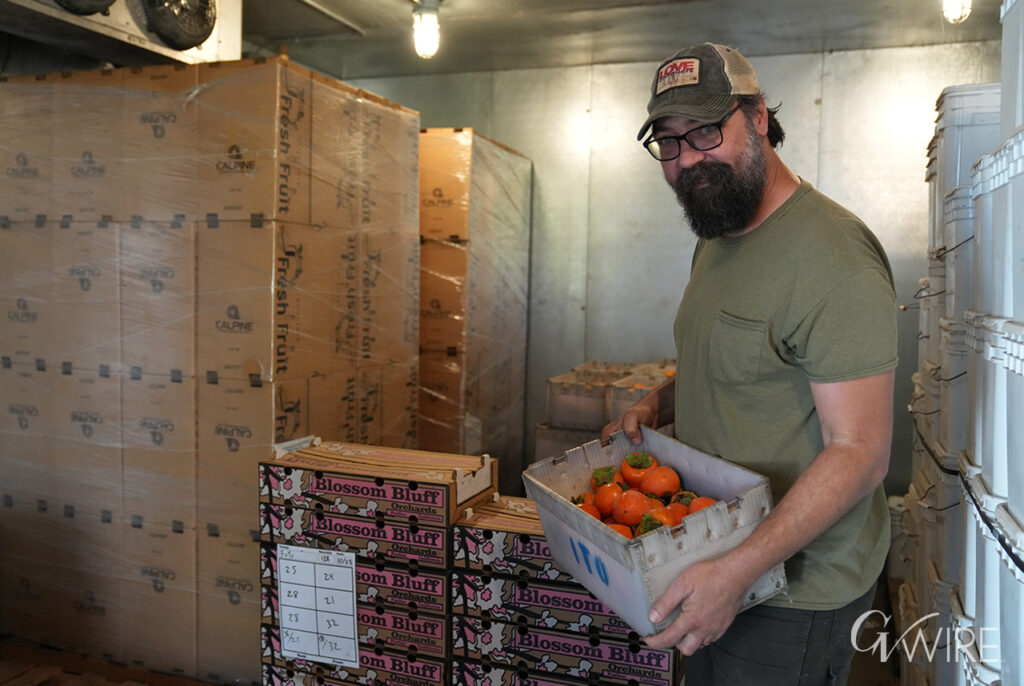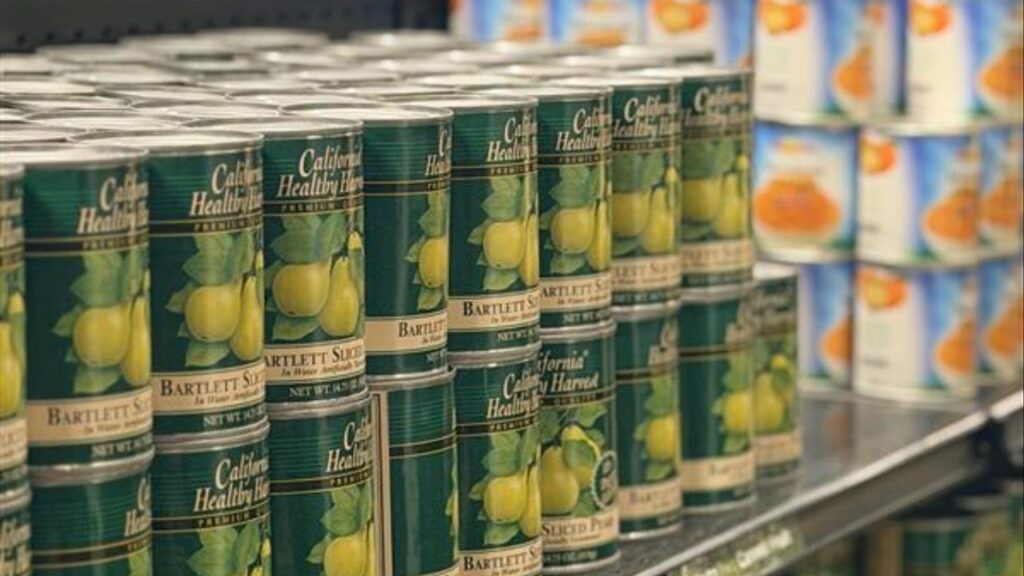Communities relying on Bay-Delta fish face health risks from pollution, as EPA investigates discrimination claims against California's water management. (CalMatters/Loren Elliott)

- EPA probes allegations that California's water policies harm communities of color relying on Bay-Delta fish.
- Pollution and algal blooms threaten the livelihoods and traditions of low-income anglers and Native tribes.
- State efforts lag in addressing contamination, leaving vulnerable populations at risk from consuming local fish.
Share
|
Getting your Trinity Audio player ready...
|
More than two dozen fishing rods were braced against the railing of San Francisco’s Pier 7, their lines dangling into the Bay. People chatted on the benches, shouting in Cantonese and leaping up when one of the rods bent or jiggled.

Rachel Becker
CalMatters
One after another, the men and women at the end of the pier reeled in striped bass as long as an arm, and even thicker.
But not King Lee, a 72-year-old retired janitor who takes the bus to the pier almost every day. It had been 10 days since he had last caught anything worth eating. “Lucky, lucky, lucky guy,” Lee said, watching an angler reeling in a thrashing fish. “Today, I got nothing. I hope, later, I get one like this.”
To a retiree living in one of the most expensive cities in the world, a good catch from the San Francisco Bay means a meal shared with family and friends — deep fried smelt or steamed striped bass with a cold beer. When the fishing is bad, dinner is rice and vegetables on most days, with maybe a little store-bought meat or fish.
Fishing “is my main job now,” said Lee, who immigrated from Hong Kong more than 40 years ago. “Here, a lot of people do the same thing. Not much money.”
From the Bay Area to Sacramento and Stockton, from Fresno to north of Redding, Californians — particularly low-income immigrants from Asian countries and other people of color — rely on the San Francisco Bay and the rivers that feed it for food. But the vast watershed is in trouble, plagued by low flows, algal blooms, urban and farm runoff and a legacy of mercury contamination that dates back to the Gold Rush.
The U.S. Environmental Protection Agency is now investigating claims that California’s management of the state’s largest estuary has “discriminated on the basis of race, color and national origin” with “its failure to update Bay-Delta water quality standards,” which involve how much water is diverted to cities and farms.
The investigation also includes allegations that the State Water Resources Control Board “has intentionally excluded tribes and Black, Asian and Latino residents from participation in the policymaking process.”
Filed by environmental justice groups and tribes, the discrimination complaint accuses the state water board of allowing the “waterways to descend into ecological crisis, with the resulting environmental burdens falling most heavily on Native tribes and other communities of color.” Water board officials wouldn’t comment on specifics, but said it is giving the EPA “relevant information to demonstrate its compliance with all civil rights laws.”

No one tallies how many people rely on Bay-Delta fish to eat, but the region has popular sport fisheries for striped bass, catfish and other fish. About 377,000 anglers from the Bay Area and Delta region are licensed to fish in California, according to California Department of Fish and Wildlife data.
About 90% of people surveyed in low-income communities of color in the Sacramento-San Joaquin Delta region reported that they eat locally caught fish four or more days per week. “This suggests that subsistence fishing plays a central role in (their) lives,” the 2021 report produced for the California Department of Water Resources says.
In addition to the Delta fish declines caused by water diversions, people of color are disproportionally harmed by contamination of the fish they eat.
Poisons have been polluting the Bay-Delta and its fish for generations. Mercury from gold mining nearly 200 years ago contaminates the sediments. Industrial chemicals past and present linger in the waterways. And a confluence of stagnation, warming waters and discharges from farms and cities foster stinking, sometimes toxic algal blooms.
African American, Lao and Vietnamese anglers who fish in the Delta ingest excessive amounts of mercury, much higher than the U.S. EPA recommends, according to a 2010 UC Davis study. Southeast Asians ate the most locally caught fish, followed by African American and Hispanic anglers.
“A whole generation of subsistence fishing families have already been exposed to harmful amounts of mercury and other poisons,” wrote Fraser Shilling, the study’s co-author who now directs the UC Davis’ Road Ecology Center.
The discrimination complaint accuses the state of allowing “waterways to descend into ecological crisis, with the resulting environmental burdens falling most heavily on Native tribes and other communities of color.”
Cintia Cortez, policy manager of Stockton-based Restore the Delta, said the Bay-Delta’s deterioration disconnects residents from the rivers and streams in their communities. “It’s their birthright to have access to safe waterways,” Cortez said.
Native tribes find their efforts to reconnect with the waterways they once called home thwarted by the plummeting populations of native fish and the noxious algae blooms.
“Tribes like us are trying to get back to those spaces, but how can we, when the state of the river is not healthy?” said Malissa Tayaba, vice chair of the Shingle Springs Band of Miwok Indians, one of the tribes that brought the complaint.
“What’s at stake is neurological learning disabilities, not being able to teach culture to future generations and not being able to eat traditional foods. We’re trying to protect our lives and our health.”
Sherri Norris, California Indian Environmental Alliance
Environmental groups want the two regional water quality boards responsible for the Bay-Delta to officially recognize subsistence and tribal fishing and cultural uses of its waterways, a step toward setting targets that protect people who use them. The Bay Area water board says it plans to propose designating tribal cultural uses in the next year, and then tribal and other subsistence fishing within five years.
The process has already dragged on too long, said Sherri Norris, executive director of the California Indian Environmental Alliance.
“What’s at stake is neurological learning disabilities, …not being able to teach culture to future generations and not being able to eat traditional foods,” Norris said. “We’re trying to protect our lives and our health.”
But cleaning the waterways enough for people to rely on them for food “could be well past any of our lifetimes, to allow natural processes to cover up the sins that we did during the Gold Rush,” said Patrick Pulupa, executive officer of the Central Valley Regional Water Quality Control Board, which manages Delta water quality issues.


In the meantime, many are unaware of the risks, despite state efforts and warnings. An easy-to-miss sign on San Francisco’s Pier 7 warns which fish are unsafe to eat, which are safe and in what quantities. But the sign is only posted in English, which only two of the roughly 12 anglers on the end of the pier that day said they could speak. Those who need translations must call a number on the sign or use a QR code to find them.
Lee has seen the warning, and doesn’t eat leopard shark because it’s highly contaminated with mercury. Otherwise, he’s not concerned — he thinks the tides keep the bay clean.
The truth, though, is that even the tides can’t wash away the poisons tainting the Delta or the Bay.
Related Story: California Pledged $500 Million to Help Tenants Preserve Affordable Housing. ...
‘That’s Why They Call It the Dirty Delta’
The vast watershed, including the Sacramento and San Joaquin river systems, stretches from around Fresno to beyond the Oregon border. The rivers come together at the Sacramento-San Joaquin Delta and flow out to the Pacific through the San Francisco Bay.
For two centuries, cities, mining, agriculture and industry have flushed the waterways with their waste, even as they’ve sapped freshwater flows.
“That’s why they call it the dirty Delta,” said Jacob Weber as he fished at the Antioch/Oakley pier on the San Joaquin River one morning. Even on a clear, bright day, the sun couldn’t penetrate the murky waters.
“You’ll get a lot of people saying, ‘Hey, let’s go out to the Delta,'” said Weber, an Oakley resident who fishes mostly for fun but will sometimes eat fish caught farther out toward the Bay. “Y’all go on your boat, but I’m not swimming in that nasty-ass water.” As for the fish, he said, “It’d be nice if they weren’t so nasty.”
Mercury, which is responsible for the majority of California’s warnings to limit eating fish from across the state, is among a cocktail of contaminants in the Bay and Delta. The heavy metal is especially dangerous for the developing brains of unborn babies and children, contributing to birth differences, developmental delays, and vision, hearing and learning difficulties.
During the Gold Rush, forty-niners mined mercury from the Coast Ranges and used it to extract gold scoured from the Sierra Nevada. Millions of pounds leached into the environment, flowing into creeks and rivers that empty into the Delta and Bay, where it has poisoned sediments and built up in fish ever since.
“You’ll get a lot of people saying, ‘Hey, let’s go out to the Delta.’ Y’all go on your boat, but I’m not swimming in that nasty-ass water. It’d be nice if the (fish) weren’t so nasty.”
Jacob Weber, fisherman at Antioch Pier
Heavy industry brought the state’s second-greatest contaminant of concern: polychlorinated biphenyls, or PCBs. Used in electric transformers and an array of products, PCBs increase cancer risk and can harm the growth and brain development of unborn babies and children. Although their manufacture was banned in 1979, the chemicals persist in sediment and fish tissues.
Flame retardants and forever chemicals known as per-and polyfluoroalkyl substances, or PFAS, also are found in San Francisco Bay and Delta fish
Because of the contamination, California’s environmental health agency warns children, teens and people who could become pregnant to completely avoid eating popular sport fish such as striped bass and sturgeon caught in the Bay and in the Northern, Central and South Delta. Men should only eat one hand-sized serving of these fish a week. For areas near the Port of Stockton and a Superfund site in Richmond, the waters are so polluted that no one is supposed to eat anything they catch.
People are wary of eating Delta fish, which cuts off a free source of food, according to a state survey of the region’s disadvantaged communities.
“Fishing has extremely deteriorated over the last 20 years, and we are now leery to eat the fish that we catch,” said one person who answered the survey. “We used to eat the fish we caught. I don’t trust the water quality anymore, but the nostalgia … is still very important to me,” said another.

Down the pier from Weber, Derrick Hines was hoping to catch a striped bass. He fishes four days a week — mostly for fun, but also to bring home fresh fish for his family, including his children.
Hines said he’s talked to some fishermen who’ve “been eating it for 30 years and they never had a problem,” he said. On the other hand, “I get people here who know people who’ve gotten sick from this type of fish.”
He and his family eat what he catches only about once or twice a month, he said. “What can we do about it? This is the water that we fish in,” Hines said. “I’m pretty sure all types of fish have some type of contaminants in it.”
Environmental groups worry that, under current water quality targets, the Bay-Delta will never be cleaned up enough to protect the people who rely on it regularly for food or cultural activities.
“The cleanup goals, even if they were going to take 100 years or 120 years, were not necessarily going to get us down to the levels that would protect these most vulnerable people,” said Andria Ventura, legislative and policy director for the nonprofit advocacy group Clean Water Action. “What do we do about … the people bringing home fish because they want to feed their family?”
Statewide about one in four households struggles with food insecurity, according to Northwestern University research.
“The uncomfortable truth is we have to look at the laws that we have available…and many of those laws would not allow us to turn the clock back to pre-Gold Rush times.”
Patrick Pulupa, Central Valley Regional Water Quality Control Board
Norris, of the California Indian Environmental Alliance, said the region’s water regulators have been dragging their feet. “It feels like they’re just hoping that tribes and communities will just give up,” Norris said.
The regulators “view fishing as a recreational choice, and not as a necessity,” said UC Davis’ Shilling. “People who are subsistence fishing, this is part of their shopping.”
The San Francisco Bay Regional Water Quality Control Board plans to conduct a survey to better understand which fish people are eating, and in what amounts, to gauge whether they need more stringent protection.
But officials say there is only so much they’ll be able to do.
“The uncomfortable truth is we have to look at the laws that we have available…and many of those laws would not allow us to turn the clock back to pre-Gold Rush times,” said Pulupa of the Central Valley water quality agency.
Related Story: California Collects Millions in Stolen Wages, but Can’t Find Many Workers ...
Blooms of Neon Green Algae
On a Saturday morning in June, Andy Ramirez was the only person fishing from a walkway around downtown Stockton’s McLeod Lake, an offshoot of the Stockton Deep Water Ship Channel portion of the San Joaquin River.
He was hoping to snag some striped bass before the lake becomes unfishable, when temperatures climb and fluorescent green algae creeps across it. The lake was spared the last two summers. But many summers, he said, “I drive over the freeway, and you can see it,” Ramirez said.
He can smell it, too. “It makes me sad,” said Ramirez, a Stockton resident who fished McLeod Lake as a child. “I think our city should take better care of the water.”
Harmful algal blooms — many of them fed by fertilizers from farm fields and urban runoff, fueled by warming temperatures and nurtured in stagnant waters — are on the rise globally and in the Bay-Delta. Back to back red tides killed tens of thousands of fish, including sturgeon, for two summers in a row in San Francisco and San Pablo bays.
Inland, blooms of microorganisms known as cyanobacteria regularly turn parts of the rivers a stinking, neon green in summer. These blooms also sometimes produce toxins that can make people sick and kill dogs and other animals, and can be so noxious that they drive people away from areas they once fished.
Jesse Zeigler, who reeled in a striped bass from the Antioch/Oakley pier, said he stopped fishing in Stockton five or six years ago because of the algae. “It was horrible,” he said. “I didn’t want to have my hands all over it. Rub your eyes or your nose, and then you’ve got another issue.”
Those same fish also contain mercury and other contaminants, so state officials warn anglers to limit their consumption and to not eat anything they catch near the Port of Stockton and in Smith Canal, including McLeod Lake, where Ramirez was fishing.

Laura Twardochleb, an environmental program manager with the State Water Resources Control Board, said the algae tend to flourish in hotspots with slow moving water and low circulation but it’s difficult to tell how important water flows are, relative to other factors like nutrients or temperature.
As California water regulators weigh new plans for managing the Bay-Delta, community groups and tribes have sounded the alarm about a $2.9 billion pact the Newsom administration reached in March 2022 with water suppliers over operations in the region.
If approved, the deal would allow major urban water providers and agricultural irrigation districts to take more water from the Delta than another regulatory proposal would permit, but would also support improving habitats.
Tribes and environmental justice groups fear the deal, along with a Newsom-backed, $20 billion proposal to replumb the Delta with a tunnel to send more water south, will worsen the stagnation and algae blooms.
Cortez of Restore the Delta remembers covering her mouth and nose with her shirt because of the stench wafting off a green McLeod lake when she went to high school nearby. “Clean, swimmable, fishable, drinkable water — when you look at our downtown, that’s not what you see,” she said.
Related Story: California Streamlines License Renewal Process for Drivers 70 and Older
The Delta Is Our Original Home: A Threat to Tribal Way of Life
For California’s Delta tribes, harmful algal blooms, dried up streams and plummeting fish populations are threatening their painstakingly revived cultures. Before Euro-American contact, Malissa Tayaba’s ancestors were fishing people whose homelands spanned seven Northern California counties, the Sacramento River and key tributaries in the Delta watershed.
Today, the Shingle Springs Band of Miwok Indians is located far from the rivers they once called home, dispossessed and displaced onto a landlocked rancheria in El Dorado County.
“Being taken from our homes really hurt us — our whole way of life is different,” said Tayaba, vice chair of the tribal council. “The Delta is our original home. It is where we come from … Whatever happens to the Delta is going to happen to us.”
In recent years, Tayaba said, the tribe purchased land where the Feather River meets the Sacramento. But even with this reconnection to the water, noxious algae and filth have forced the tribe to cancel ceremonies and events at sites along the river.

Polluted waters give members pause about processing riverside plants for basketry the traditional way, using their hands and mouths. Once-abundant salmon that the tribe historically relied on have declined so much that commercial and recreational fishing have been canceled in inland rivers and off California’s coast for two years in a row.
It’s a blow to tribes across California that rely heavily on salmon and say that historically members often ate locally caught fish at least daily. More now report that they eat fish they catch once a week or less.
“It’s not good quality water. I remember when I was a kid, we would eat a bunch of fish out of the Delta. Now not as much.”
Jesse Galvan, California Valley Miwok tribe Member
Jesse Galvan, a member of the California Valley Miwok tribe, works as the Tribal Historic Preservation Office coordinator for the Buena Vista Rancheria of Me-Wuk Indians.
Galvan said he spent many years fishing throughout the Delta with his grandfather, whom he called Papa and who died this summer. But he, too, is wary about eating what he catches, especially in more urbanized areas like Stockton.
“The water is just horrible. It looks really bad, it looks really murky. It’s not good quality water. You just think about that before you want to eat that fish,” Galvan said. “It’s a sad thing. I remember when I was a kid, we would eat a bunch of fish out of the Delta. Now not as much.”
Still, he said, he tries to fish as much as he can — even if it’s just catch-and-release.
“With the wars on water, you’ve got to cherish it as long as we’ve got it,” he said. “I don’t know when the government is going to tell me ‘hey you just can’t fish no more’ … All those memories I have with my grandfather, my Papa, will be gone. They’ll just be memories.”
About the Author
Rachel Becker is a journalist reporting on California’s complex water challenges and water policy issues for CalMatters. She’s covered drought, water standoffs, groundwater depletion, water quality and the world’s biggest dam removal.
About CalMatters
CalMatters is a nonprofit, nonpartisan newsroom committed to explaining California policy and politics.



















